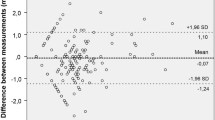Abstract
Objectives
To compare the amount of fluid in synovial sheaths of the ankle before and after running. Our hypothesis was that this amount would increase and that the threshold for what is normally acceptable should be adjusted after physical activity.
Methods
Twenty-one healthy volunteers (n = 42 ankles) ran for 40 min on a treadmill. They underwent 3 T MRI before and immediately after running using a dedicated ankle coil. The images were stored and subsequently measured in a standardized way and independently read by two readers for fluid in the tendon sheaths in the retro and inframalleolar area. Statistics were performed for each tendon (Wilcoxon signed rank test), and also for the pooled data. Intraclass correlation coefficients were calculated.
Results
For reader 1, for all tendons the values after running increased without reaching statistical significance. For reader 2 this was not the case for all tendons but for most. When all the data were pooled (n = 800 measurements), the statistical difference before and after running was significant (p < 0.001).
Conclusion
Data pre and post-running show a trend of increasing synovial fluid, however, not significant for each individual tendon. The pooled data for all tendons, (n = 800) show a statistically significant increase after running (p < 0.001). The clinical implication is that the threshold for normally acceptable fluid should be adjusted if the patient undergoes an MR study after recent physical activity.





Similar content being viewed by others
Availability of data and materials
All the available measurement data are provided in the manuscript.
Abbreviations
- PL:
-
Peroneus longus
- PB:
-
Peroneus brevis
- TP:
-
Tibialis posterior
- FDL:
-
Flexor digitorum longus
- FHL:
-
Flexor halluces longus
- TA:
-
Tibialis anterior
- EDL:
-
Extensor digitorum longus
- EH:
-
Extensor hallucis
- Pre:
-
Prior to running
- Post:
-
Following the running exercise
References
Akhbari P, Jaggard MK, Boulangé CL, Vaghela U, Graça G, Bhattacharya R, Lindon JC, Williams HRT, Gupte CM (2019) Differences in the composition of hip and knee synovial fluid in osteoarthritis: a nuclear magnetic resonance (NMR) spectroscopy study of metabolic profiles. Osteoarthr Cartil 27:1768–1777. https://doi.org/10.1016/j.joca.2019.07.017
Burke CJ, Alizai H, Beltran LS, Regatte RR (2019) MRI of synovitis and joint fluid. J Magn Reson 49:1512–1527. https://doi.org/10.1002/jmri.26618
Cheung Y, Rosenberg ZS, Magee T, Chinitz L (1992) Normal anatomy and pathologic conditions of ankle tendons: current imaging techniques. Radiographics 12:429–444. https://doi.org/10.1148/radiographics.12.3.1609136
De Grove V, Willekens I, Lenchik L, Shahabpour M, de Mey J, De Maeseneer M (2018) Surg Radiol Anat 40:481–487. https://doi.org/10.1007/s00276-017-1924-x
Hoessly ML, Wildi LM (2017) Magnetic Resonance Imaging Findings in the Knee Before and After Long-Distance Running-Documentation of Irreversible Structural Damage? A Systematic Review. Am J Sports Med 45:1206–1217. https://doi.org/10.1177/0363546516656180
Kingston AR, Toms AP, Ghosh-Ray S, Johnston-Downing S (2009) Does running cause metatarsophalangeal joint effusions? A comparison of synovial fluid volumes on MRI in athletes before and after running. Skeletal Radiol 38:499–504. https://doi.org/10.1007/s00256-008-0641-2
Nazarian LN, Rawool NM, Martin CE, Schweitzer ME (1995) Synovial fluid in the hindfoot and ankle: detection of amount and distribution with US. Radiology 197:275–278. https://doi.org/10.1148/radiology.197.1.7568837
Otterness IG, Eskra JD, Bliven ML, Shay AK, Pelletier JP, Milici AJ (1998) Exercise protects against articular cartilage degeneration in the hamster. Arthritis Rheumatol 41:2068–2076. https://doi.org/10.1002/1529-0131(199811)41:11%3c2068::AID-ART23%3e3.0.CO;2-L
Pratt DJ (1989) Mechanisms of shock attenuation via the lower extremity during running. Clin Biomech 4:51–57. https://doi.org/10.1016/0268-0033(89)90068-5
Schmidt WA, Schmidt H, Schicke B, Gromnica-Ihle E (2004) Standard reference values for musculoskeletal ultrasonography. Ann Rheum 63:988–994. https://doi.org/10.1136/ard.2003.015081
Schweitzer ME, van Leersum M, Ehrlich SS, Wapner K (1994) Fluid in normal and abnormal ankle joints: amount and distribution as seen on MR images. AJR Am J Roentgenol 162:111–114. https://doi.org/10.2214/ajr.162.1.8273647
Teitz CC, Garrett WE Jr, Miniaci A, Lee MH, Mann RA (1997) Tendon problems inathletic individuals. Instr Course Lect 46:569–582. https://doi.org/10.2106/00004623-199701000-00016
Trevino S, Baumhauer JF (1992) Tendon injuries of the foot and ankle. Clin Sports Med 11:727–739. https://doi.org/10.1016/S0278-5919(20)30481-6
Wang YX, Westwood FR (2006) Fluid collection within the synovial sheath of the tendon of the flexor hallus longus muscle in the tarsal joint of rats: ananatomic variant detectable with magnetic resonance imaging. Lab Anim (NY) 40:58–62. https://doi.org/10.1258/002367706775404381
Willekens I, Shahabpour M, Lenchik L, Buls N, De Mey J, Provyn S, De Maeseneer M (2019) Fluid distribution in ankle tendon sheaths in healthy volunteers: MRI findings. Surg Radiol Anat 41:1445–1449. https://doi.org/10.1007/s00276-019-02355-z
Funding
No funding was received.
Author information
Authors and Affiliations
Contributions
MD: study design, manuscript writing, SD: data collection, VDG: data collection, NB: statistical analysis, JDM: study design, manuscript review, MS: manuscript writing and review, SP: study design, data collection, IW: study design, experiment, data analysis.
Corresponding author
Ethics declarations
Competing interests
The authors declare no competing interests.
Conflict of interests
No conflicts of interest or competing interests to declare by the authors.
Ethical approval
Ethical committees Vrije Universiteit Brussel. Consent to participate and consent to publish were obtained from the subjects.
Additional information
Publisher's Note
Springer Nature remains neutral with regard to jurisdictional claims in published maps and institutional affiliations.
Rights and permissions
Springer Nature or its licensor (e.g. a society or other partner) holds exclusive rights to this article under a publishing agreement with the author(s) or other rightsholder(s); author self-archiving of the accepted manuscript version of this article is solely governed by the terms of such publishing agreement and applicable law.
About this article
Cite this article
De Maeseneer, M., Doering, S., De Grove, V. et al. Physical activity increases synovial fluid in ankle tendon sheaths: an adjustment of MR Criteria is needed. Surg Radiol Anat 45, 193–199 (2023). https://doi.org/10.1007/s00276-022-03068-6
Received:
Accepted:
Published:
Issue Date:
DOI: https://doi.org/10.1007/s00276-022-03068-6




